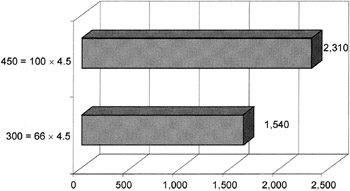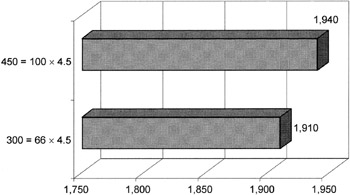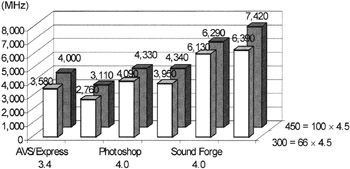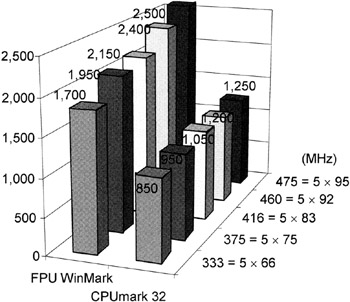Overclocking Computers with Intel Pentium II
|
| < Day Day Up > |
|
This section describes the results of overclocking computers based on the following processors:
-
Pentium II 300 MHz
-
Pentium II 333 MHz
Computer with Pentium II 300 MHz
Pentium II processors with a clock frequency of 300 MHz operate well in over-clocked modes. Overclocking will be particularly successful if such processors are used with motherboards that have built-in overclocking capabilities. The best motherboards include Abit BX6. This particular motherboard allows very high performance to be achieved.
The following results came from overclocking and testing a computer with a Pentium II 300 MHz processor and an Abit BX6 motherboard. Overclocking parameters were set using BIOS Setup in CPU SoftMenu II.
System Configuration
-
Processor — Intel Pentium II 300 MHz (integrated coprocessor, 32 KB L1 cache, 512 KB L2 cache, recommended processor-bus frequency of 66 MHz, 2 V core supply)
-
Motherboard — Abit BX6
-
Hard disk — Western Digital 8.4 GB
-
RAM — 64 MB, SDRAM
-
Video adapter — Asus V3400TNT
-
CD-ROM drive — Advanced Technology Attachment Packet Interface (ATAPI) 40x
-
Operating system — Windows 98 (4/10/98)
Establishing Overclocking Modes
The following settings were specified in BIOS Setup (Award Modular BIOS v4.51PG):
-
CPU operating speed — User defined
-
Turbo frequency — Disabled
-
External clock — 100 MHz
-
Multiplier clock — 4.5x
-
AGPCLK/CPUCLK — 2/3 (relative speeds of the AGP and CPU bus clocks)
-
Speed error hold — Enabled
-
CPU power supply — User defined
-
Core voltage — 2.10 V
In the course of overclocking, the system-bus frequency was raised from 66 MHz to 100 MHz. As a result, the processor frequency was increased 1.5 times, from 300 MHz to 450 MHz. To ensure stable operation, the core voltage was raised from 2.00 V to 2.10 V. To retain control over the system, the system temperature was monitored constantly, using the System Temperature parameter in the CHIPSET Features Setup menu. Before overclocking, the temperature was 41°C (106°F); after this procedure, it was 42°C (108°F).
Testing the System
The following WinBench 99 tests were conducted: FPU WinMark (Fig. 18.1) [1], business disk, and high-end disk. (See Figs. 18.2–18.4 and Tables 18.1 and 18.2.) Unfortunately, the CPUmark 99 test could not be loaded, presumably because of instability of the operating system used in the test (Windows 98).
| WinBench 99 test | 300 MHz ≈ 66 × 4.5 | 450 MHz = 100 × 4.5 |
|---|---|---|
| FPU WinMark | 1,540 | 2,310 |
| WinMark 99 business disk (1,000 bytes/sec) | 1,910 | 1,940 |
| WinMark 99 high-end disk (1,000 bytes/sec) | 5,630 | 5,930 |
| WinMark 99 high-end disk | 300 MHz ≈ 66 × 4.5 | 450 MHz = 100 × 4.5 |
|---|---|---|
| AVS/Express 3.4 | 3,800 | 4,000 |
| FrontPage 98 | 27,600 | 31,100 |
| Photoshop 4.0 | 4,090 | 4,330 |
| Premiere 4.2 | 3,950 | 4,340 |
| Sound Forge 4.0 | 6,130 | 6,290 |
| Visual C++ 5.0 | 6,390 | 7,420 |

Figure 18.1: Pentium II 300 MHz processor performance (FPU WinMark)

Figure 18.2: Pentium II 300 MHz hard-disk performance (WinMark 99 business disk)

Figure 18.3: Pentium II 300 MHz hard-disk performance (WinMark 99 high-end disk)

Figure 18.4: Pentium II 300 MHz test results (WinMark 99 high-end disk)
Computer with Pentium II 333 MHz
Pentium II 333 MHz is one of the most popular processor models. It shows good results in tests and is one of the best representatives of the Pentium II product line.
Pentium II 333 MHz shows high overclocking results. It is possible to overclock this processor to 416 MHz (5 × 83 MHz).
With some motherboards that support higher frequencies of the host bus (such as 92 MHz or 95 MHz), it was possible to overclock this processor to 460 MHz. However, at these frequencies, additional cooling of the processor and other hardware components is required.
Processor overclocking was accomplished by raising the system-bus frequency from 66 MHz to 95 MHz. At system-bus frequencies of 83 MHz, 92 MHz, and 95 MHz (relatively high for products of this class), computer operation was unstable. At frequencies of 92 MHz and 95 MHz, the system often hung up during the tests, even with an improved cooling system. It was possible to ensure stable operation of the system only by increasing the CPU core voltage 0.1 V.
WinBench 98 was used for testing.
Test results (Table 18.3 and Fig. 18.5) show significant growth of overall system performance, achieved by processor overclocking. However, as previously mentioned, system operation was unstable at high system-bus frequencies of 83 MHz, 92 MHz, and 95 MHz (416 MHz, 460 MHz, and 475 MHz processor frequencies) without an appropriate increase in CPU core voltage.
| Parameters (MHz) | CPUmark 32 rating | FPU WinMark rating |
|---|---|---|
| 333 = 5 × 66 | 850 | 1,700 |
| 375 = 5 × 75 | 950 | 1,950 |
| 416 = 5 × 83 | 1,050 | 2,150 |
| 460 = 5 × 92 | 1,200 | 2,400 |
| 475 = 5 × 95 | 1,250 | 2,500 |

Figure 18.5: Pentium II 333 MHz test results
Without increasing the CPU core voltage, the optimal and most recommended mode is 375 MHz (5 × 75 MHz). With increased CPU core voltage, the optimal mode is 416 MHz (5 × 83 MHz).
As usual, when overclocking the processor, it is necessary to carefully consider efficient cooling.
[1]In all figures of this chapter, except Figs. 18.4, 18.5, and 18.21, the vertical axis is in megahertz and the horizontal axis is the rating.
|
| < Day Day Up > |
|
EAN: 2147483647
Pages: 111